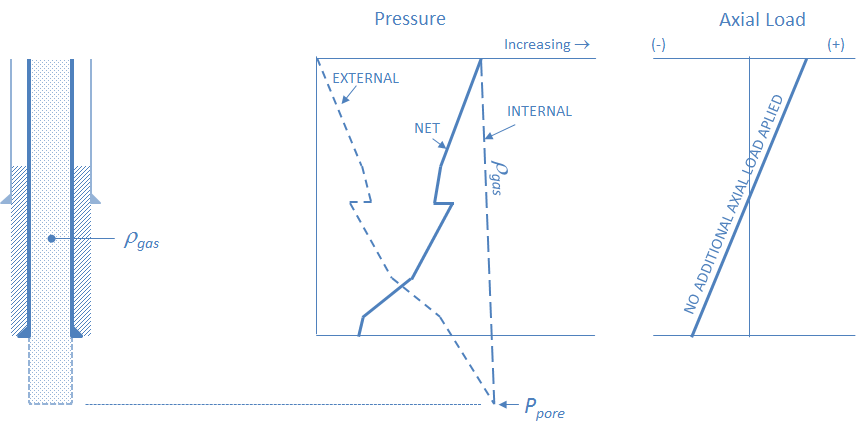¶ Kick: Casing Full of Gas
The Kick: Casing Full of Gas load case can be thought of as a special case of the Kick: Gas Influx load case with the Gas Percentage set to 100%. It assumes a situation where the entire casing is filled with the influx fluid (gas).
If the internal pressure at the shoe due to the influx is greater than the fracture pressure at the shoe, a warning message will appear.
This load case is usually defined as a Post-Installation Load Case.

¶ Inputs
This load case utilizes the Undisturbed Temperature Profile.
The inputs include:
- Description
- Pressure at Hanger
- Gas Density
- Gas Gradient
- Internal Pressure Profile
The Description is nothing more than the load's name, which can be edited by the well designer.
The Pressure at Hanger is the hydrostatic pressure of the annulus fluid at the wellhead. The default value is the pressure resulting from the mud density in which the string was run. While this field can be edited, it will rarely need to be.
The Gas Density and Gas Gradient fields are tied together -- editing one automatically changes the other. The default value for Gas Density is 2.50 ppg or 0.13 psi/ft.
For the Internal Pressure Profile, the user has a choice between three scenarios: assuming an influx pressure due to the fracture pressure at the shoe, an influx pressure due to the pore pressure at the influx depth, or to use the smaller of the two resulting pressures at the shoe. The radio button selection switches between these options. The internal pressure at any depth is calculated by subtracting the hydrostatic pressure exerted by the specified gas density in the wellbore from the internal pressure at the casing shoe (by default), or from the pressures and depths indicated in the Influx table (alternative user inputs).
External Pressure Options include:
- Original Mud Weight
- Base Fluid Density
- Sea Water
- Fresh Water
- Cement Mix Fluid Density
- Cement Slurry Density
- Pore Pressure Gradient
- Fracture Pressure Gradient
- Custom
The Original Mud Weight, Base Fluid Density, Sea Water Gradient, Fresh Water Gradient, Cement Mix Fluid Density and Cement Slurry Density, all have default values assigned to them. Values shown for the Original Mud Weight and Cement Slurry Density, which are specific to the string under consideration, were input by the well designer in the Casing Program Table. The other default values are assigned by StrinGnosis® and cannot be edited. All are constants, except for Base Fluid Density which is either 8.33ppg or 7.00ppg EMW, depending on whether water or oil based mud is specified.
Any of the available fluid choices may be assigned to any region of the wellbore annulus. StrinGnosis® will select the annulus fluids for the default condition based on a set of rules defined in the External Pressure Assumptions Section. The StrinGnosis® default for all Collapse load cases is the hydrostatic pressure of the mud that the casing was run in. These rules have been carefully considered to provide a reasonably conservative estimate of the annular conditions for the load under consideration. A thorough understanding of these assumptions is advised before manually altering the default fluid selections.
¶ Load Case Example
